Answer these simple questions and we will find you the BEST prices
Which type of solar quotes do you need?
It only takes 30 seconds
100% free with no obligation

Get Free quotes from insulation specialists near you

Save money by comparing quotes and choosing the most competitive offer

The service is 100% free and with no obligation
- GreenMatch
- Insulation
- Insulation Building Regulations
- Loft Insulation Regulations
What are the Loft Insulation Regulations in the UK (2025)

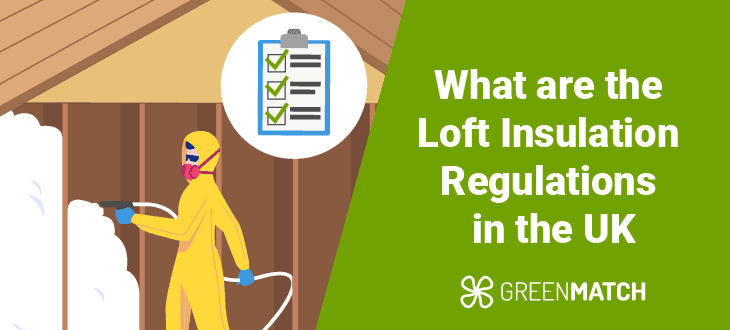
- The recommended loft insulation thickness is at least 270mm to achieve the optimal U-value of 0.16 W/m²K.
- Loft insulation regulations recommend maintaining a 50mm gap between insulation and the roof deck to prevent condensation and mould.
- Non-compliance with loft insulation regulations may lead to project delays, potential fines, or even prosecution.
Loft insulation is one of the most effective ways to enhance energy efficiency, minimise heat loss, and reduce energy bills in your home. However, proper installation requires more than just adding insulation. It must comply with loft insulation regulations to ensure safety and optimal performance.
Before you insulate your loft it's crucial to research and familiarise yourself with the regulations. These rules cover important aspects like insulation thickness, U-values, ventilation, and fire safety—all of which are key to creating a safe and efficient space.
Whether you're converting your loft into a bedroom, office, or extra living space, or simply aiming to improve your home's energy efficiency, staying current on the relevant regulations is critical. This will provide peace of mind and help you avoid any potential legal issues arising from non-compliance.
This guide explores key loft insulation regulations and how different materials and methods help meet these standards. Following these guidelines will improve energy efficiency and ensure the success and safety of your insulation project.
If you're ready to insulate your loft and comply with loft insulation regulations, finding the right specialist is crucial. Instead of spending time comparing quotes yourself, let GreenMatch help. We provide up to four free quotes from top insulation specialists in your area.Fill out our 30-second form to get started. Click below to learn more.
- Describe your needs
- Get free quotes
- Choose the best offer
It only takes 30 seconds



Loft insulation thickness regulations
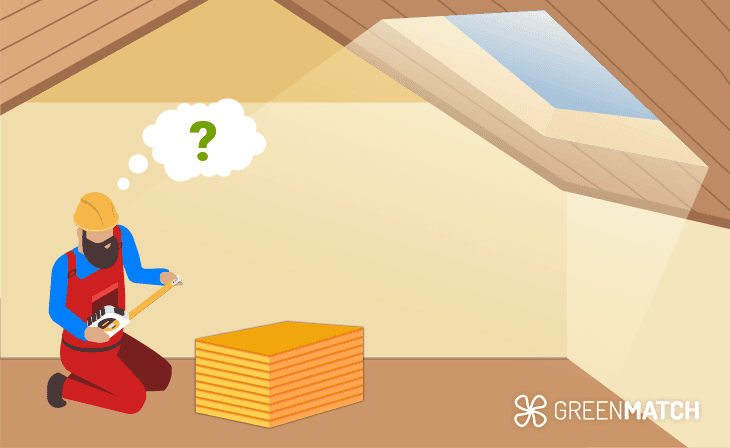
Loft insulation thickness regulations require a minimum of 270mm to meet the maximum U-value. If you're replacing loft insulation or your loft lacks insulation, ensure the new material reaches this standard. If existing insulation is in good condition, you can layer more on top to achieve the required thickness.
These regulations apply to both cold and warm loft insulation. Warm loft insulation, which is loft insulation between the rafters, can reduce the head height in a room. If this happens, it’s recommended to consult experts and your local authority to consider adjustments. For flat roofs, adding insulation to the exterior of the roof deck may require planning permission. So, it's essential to coordinate with your local authority to avoid issues related to changes in roof height and appearance.
Although the general minimum loft insulation in the uk is 270mm to meet U-value requirements, some insulation materials have a higher R-value, which means better resistance to heat flow. With a higher R-value, you may need less material to achieve the same level of insulation.
| Insulation material | Recommended thickness |
|---|---|
| Spray foam | 150mm |
| Rigid foam board | 150mm |
| Cellulose | 220mm |
| Mineral wool | 270mm |
| Fibreglass | 270mm |
These loft insulation thickness regulations apply uniformly across the UK, including England, Scotland, Wales, and Northern Ireland. While it's crucial to install the correct thickness for maximum thermal efficiency, reduced energy bills, and improved comfort, it's also important to note that adding too much insulation can be unnecessary. Beyond a certain thickness, additional insulation will not further reduce the U-value, meaning any extra material will cost more without providing additional benefits.
Loft insulation regulations and U-values
Loft insulation regulations in the UK are designed to improve energy efficiency and reduce home heat loss. A key measure in these regulations is the U-value, which indicates how effectively the insulation prevents heat transfer. The lower the U-value, the better the insulation.
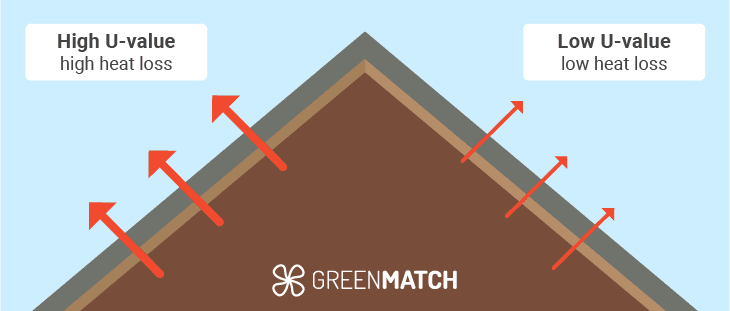
For loft insulation, the recommended U-value is 0.16 W/m²K. Achieving this level of thermal efficiency typically requires around 270mm of insulation using common materials like fibreglass or mineral wool. However, depending on the type of insulation, such as rigid foam or spray foam, a thinner layer may achieve the same U-value due to its higher insulating properties.
Each material has an R-value, which means better resistance to heat flow; the higher the R-value, the better it will be to attain a lower U-value. Spray foam and rigid foam boards are the best insulation for lofts as they provide the highest R-values.
Proper insulation helps reduce energy bills, improves comfort, and lowers carbon footprint. Whether upgrading your existing insulation or installing it for the first time, meeting the recommended U-value is crucial for long-term savings and energy efficiency.
To find the best insulation to attain the recommended U-value, you must work alongside insulation specialists who help you choose the right insulation that aligns with loft insulation regulations. Here at GreenMatch, we can make this process quick and easy. All you have to do is fill out our 30-second form, and we can provide you with up to four free quotes from the top insulation specialists in your area. Click below to learn more.
- Describe your needs
- Get free quotes
- Choose the best offer
It only takes 30 seconds



Loft insulation ventilation regulations
Proper ventilation is a crucial part of loft insulation regulations in the UK. While insulation is critical to retaining heat and improving energy efficiency, effective ventilation prevents moisture buildup in your roof space, reducing the risk of damp, mould, and structural damage.
When lofts are insulated, warm air from the house can rise and meet cooler roof surfaces, creating condensation. Without adequate ventilation, this moisture can build up, leading to long-term problems. Ensuring proper airflow prevents condensation and keeps your loft dry.
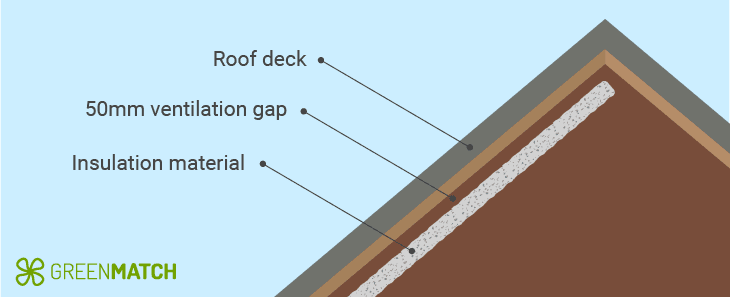
To meet loft insulation regulations, leaving a 50mm air gap between the insulation and the roof covering is essential. This gap allows air to circulate freely and prevents moisture buildup. If roof trimmers or hips block airflow from the eaves to the ridge, you can drill 25mm holes in these members to maintain continuous ventilation, even when structural elements obstruct direct airflow.
By ensuring proper ventilation, you comply with loft insulation regulations and protect your insulation, boost energy efficiency, and safeguard your home from moisture-related issues.
Loft insulation regulations for fire safety
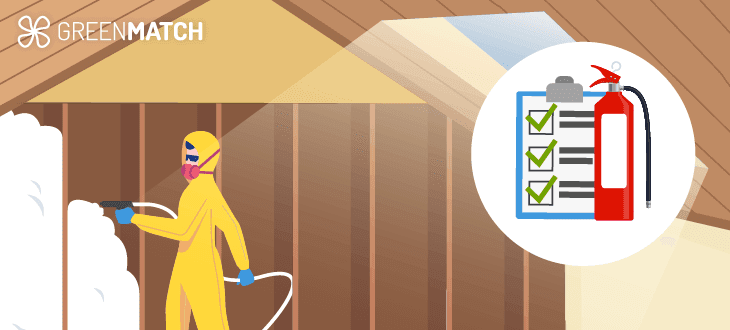
Fire safety is essential when installing loft insulation, and UK loft insulation regulations ensure that materials used in your home meet specific fire-resistant standards. Insulation that does not comply with these regulations can pose a significant fire hazard, particularly in a loft space where wiring and heat sources may increase the risk of ignition.
Lofts can be a vulnerable area in the event of a fire, as they are often difficult to access and may contain materials contributing to the spread of flames. Choosing fireproof loft insulation is crucial to reduce the risk of fire spreading through the roof space. Fire-resistant insulation materials can help slow down or prevent the spread of fire, giving occupants more time to evacuate and emergency services more time to respond.
To comply with loft insulation regulations for fire safety, select insulation materials that meet UK fire resistance standards, such as mineral wool, which is naturally fireproof. Additionally, ensure that the insulation is installed correctly, with no gaps allowing heat to build up around electrical fixtures or wiring. Keeping wiring and insulation separate or using fire-retardant barriers can also help prevent potential hazards.
Proper installation and maintenance of fireproof loft insulation can significantly reduce the risk of fire hazards in your loft space. Following loft insulation regulations, you can protect your home, enhance fire safety, and ensure your insulation complies with all necessary safety standards.
How can you ensure your loft insulation complies with regulations?
Ensuring your loft insulation meets UK regulations is essential for improving energy efficiency, reducing heat loss, and maintaining safety standards. Non-compliance with loft insulation regulations can lead to construction delays and potential fines or prosecution. These regulations cover insulation thickness, U-values, ventilation, and fire safety, making it a complex process.
Working with professional loft insulation companies who understand loft insulation regulations is essential to ensure compliance. These experts can assess your loft, recommend the best insulation materials, and guarantee proper installation. They'll also address critical aspects such as fire safety, adequate ventilation, and achieving the correct U-value, helping you avoid costly errors and ensuring everything meets legal standards.
Certified installers have the experience to navigate these detailed regulations and ensure your insulation is effective and compliant. They can help you select the most suitable insulation, whether fireproof materials, high R-value insulation, or the most economical options for your home.
At GreenMatch, we make it easy to find the right professionals. Fill out our 30-second form to receive up to four free quotes from trusted local insulation specialists. Let us help you connect with experts who will ensure your loft insulation complies with all regulations and maximises energy efficiency. Click below to learn more!
- Describe your needs
- Get free quotes
- Choose the best offer
It only takes 30 seconds



FAQ
In 2024, UK loft insulation rules require a minimum insulation thickness of 270mm to meet a U-value of 0.16 W/m²K, along with proper ventilation and fire safety compliance.
The current regulation for loft insulation in the UK requires a minimum thickness of 270mm to achieve a U-value of 0.16 W/m²K, along with proper ventilation and fire safety measures.
No, 100mm of insulation is not enough in a loft, as current UK regulations require a minimum of 270mm to meet the recommended U-value for proper thermal efficiency.
300mm of loft insulation is not excessive and won’t negatively impact thermal efficiency. However, beyond a certain thickness, adding more insulation won’t further reduce the U-value, so extra material may increase costs without offering additional benefits.

Caoimhe is an experienced content writer and researcher who is passionate about providing accessible information to every reader. With a background in English literature and Sociology, she combines the two disciplines to create cohesive, well-thought-out, and well-informed pieces.
We strive to connect our customers with the right product and supplier. Would you like to be part of GreenMatch?

